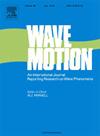淹没杆阵的波散射:一种解析方法
IF 2.5
3区 物理与天体物理
Q2 ACOUSTICS
引用次数: 0
摘要
本文给出了用杆阵检测表面重力波散射的详细解析解。根据入射波周期的不同,条形曲线被建模为梯形或驼峰形。我们将该问题表述为由缓坡方程控制的边值问题,并采用传递矩阵法确定散射系数。我们的分析表明,棒数及其间距调制布拉格谐振特性,谐波峰之间的次谐波峰数比棒数少两个。对于非均匀条形阵列,出现彩虹反射,抑制了次谐波峰,消除了波反射中的多个零点。当坝长接近水深时,波衍射变得显著。均匀条形阵列的完全波反射表现出类似于光学中的法布里-普氏共振的行为。布拉格反射模式表现出独特的特性:偶数条有共同的零最小值,奇数条有共同的最大值。当检查相反的情况-淹没沟槽而不是条形-我们观察到相似的谐波和次谐波分量具有一致的相移和显著降低的反射波振幅。波场分析显示了三个不同的区域:入射侧的驻波,背风侧的进行波和杆间受限区域的部分驻波。杆系的倾斜几何形状引起波折射和振幅衰减。二维线性随时间变化的地表高程,利用高斯脉冲模拟,捕捉了整个淹没多棒系统的瞬态波变换动力学。本文章由计算机程序翻译,如有差异,请以英文原文为准。
Wave scattering by an array of submerged bars: An analytic approach
This paper provides a detailed analytic solution for examining the scattering of surface gravity waves by an array of bars. Depending on the incident wave period, bars are modelled as either trapezoidal or hump-shaped profiles. We formulate the problem as a boundary value problem governed by the mild-slope equation and employ the transfer matrix method to determine the scattering coefficients. Our analysis reveals that the number of bars and their spacing modulate Bragg resonance characteristics, with the number of sub-harmonic peaks between harmonic peaks being two fewer than the number of bars. For non-uniform bar arrays, rainbow reflection occurs, suppressing sub-harmonic peaks and eliminating multiple zeros in wave reflection. As the bar length approaches the water depth, wave diffraction becomes significant. Complete wave reflection by uniform bar arrays demonstrates a behaviour analogous to Fabry-Pérot resonance in optics. The Bragg reflection patterns exhibit distinctive properties: common zero minima for even numbers of bars and common maxima for odd numbers. When examining the inverse case — submerged trenches instead of bars — we observe similar harmonic and subharmonic components with consistent phase shifts and notably reduced reflected wave amplitudes. Wave field analysis demonstrates three distinct regions: standing waves on the incident side, progressive waves on the leeward side, and partly standing waves in the confined region between bars. The sloped geometries of the bar systems induce wave refraction and amplitude decay. Two-dimensional linear time-dependent surface elevations, simulated using a Gaussian pulse, capture the transient wave transformation dynamics throughout the submerged multi-bar systems.
求助全文
通过发布文献求助,成功后即可免费获取论文全文。
去求助
来源期刊

Wave Motion
物理-力学
CiteScore
4.10
自引率
8.30%
发文量
118
审稿时长
3 months
期刊介绍:
Wave Motion is devoted to the cross fertilization of ideas, and to stimulating interaction between workers in various research areas in which wave propagation phenomena play a dominant role. The description and analysis of wave propagation phenomena provides a unifying thread connecting diverse areas of engineering and the physical sciences such as acoustics, optics, geophysics, seismology, electromagnetic theory, solid and fluid mechanics.
The journal publishes papers on analytical, numerical and experimental methods. Papers that address fundamentally new topics in wave phenomena or develop wave propagation methods for solving direct and inverse problems are of interest to the journal.
 求助内容:
求助内容: 应助结果提醒方式:
应助结果提醒方式:


